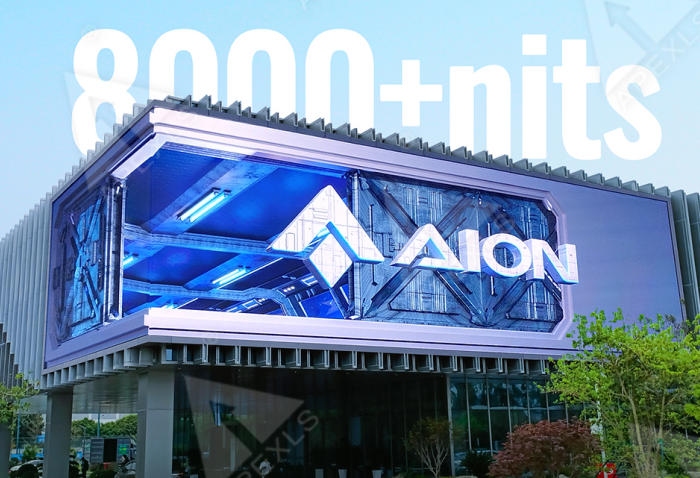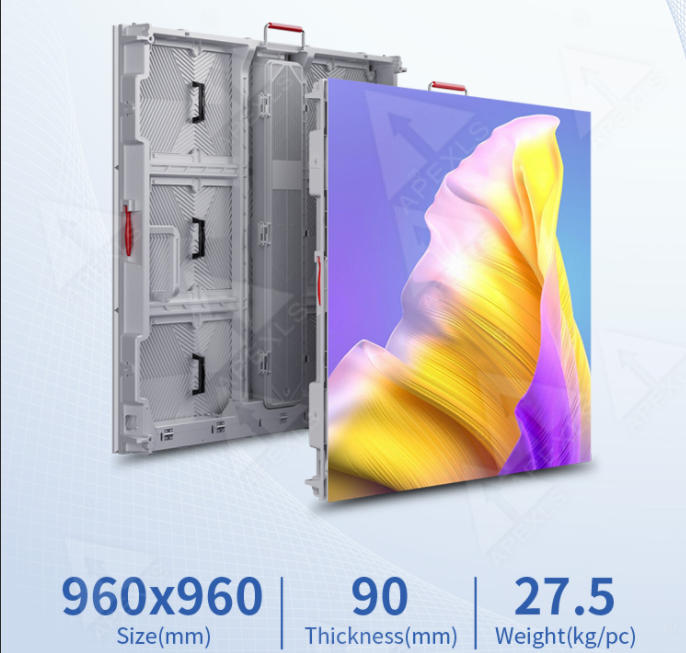When advertising screens turn into "blank boards" under the midday sun, when monitoring screens frequently go black after heavy rains, and when the high electricity costs of conventional outdoor large screens trouble operators—these problems often stem from choosing the wrong type of screen. In complex outdoor environments, regular indoor screens, limited by their design orientation, struggle to cope with challenges such as strong light, extreme temperature and humidity, and long-term high-load operation. In contrast, outdoor high-brightness screens, with targeted technological upgrades, have become the core solution to address the pain points of outdoor display.
This article will delve into the fundamental differences between outdoor high-brightness screens and regular screens from three core dimensions: brightness adaptability, environmental protection capability, and long-term power consumption costs. It will focus on explaining how Apexls's outdoor dynamic energy-saving screens achieve "high brightness without high power consumption and durability against extreme conditions" through innovative technologies. Meanwhile, it will recommend capable manufacturers with solid technology and a good reputation for users in different scenarios, helping you avoid misunderstandings in selecting outdoor display screens.

Apexls Outdoor High-Brightness Dynamic Energy-Saving Screen, with a brightness of over 8000 nits.
(I) Brightness: The "Visibility Lifeline" in Strong Light Environments
Brightness is a core indicator of outdoor displays, directly determining the readability of images under natural light. The brightness of regular screens is usually only 200-5000 cd/㎡. Under direct midday sunlight, the images on these screens suffer from severe glare, blurred details, and may even become completely invisible. In contrast, the brightness of outdoor high-brightness screens can easily reach over 6000 cd/㎡, and some high-end models even exceed 10000 cd/㎡, achieving clear display effects that are "visible under sunlight".
Take Apexls's outdoor dynamic energy-saving screens as an example. While ensuring high-brightness display, they have made technological breakthroughs: through an intelligent light-sensing system that monitors ambient light in real time, the brightness parameters are automatically adjusted. High clarity is maintained under strong midday light, and the brightness is reduced to a low level at night. This not only meets the scenario requirements but also avoids energy waste.
(II) Protection: The "Durability Shield" Against Extreme Environments
Fluctuations in temperature and humidity, wind, rain, sand, dust, and accidental impacts in outdoor environments place strict demands on the protection capability of screens. The operating temperature range of regular screens is mostly limited to 0℃-50℃. At low temperatures, they are prone to image retention and slower response, while at high temperatures, they may experience blackouts or even burnout. Moreover, regular screens lack professional dustproof and waterproof designs, leading to frequent malfunctions when used outdoors.
Outdoor high-brightness screens, on the other hand, take "environmental adaptability" as their core design goal:
Wide temperature adaptation: Through special materials and circuit optimization, the operating temperature can cover -40℃ to 60℃, easily coping with the severe cold in northern China and the extreme heat in southern China.
Protection level: They generally meet the IP65 or higher dustproof and waterproof standards, and some high-end models can even reach IP66, capable of withstanding strong water jet sprays and high-salt mist environments.
Structural reinforcement: They adopt aluminum alloy casings for effective load-bearing, ensuring flat splicing without deformation.
Apexls's outdoor dynamic energy-saving screens have been further optimized on this basis. The modules adopt a hard-connection plug-and-play design, which not only improves the stability of signal transmission but also enhances the structural tightness. Combined with multiple protection systems such as lightning protection and leakage prevention, they are suitable for the long-term operation needs of complex scenarios such as smart cities and outdoor advertising.
(III) Power Consumption: The "Cost Control Core" for Long-Term Operation
Conventional outdoor screens mostly need to operate continuously 24/7, so power consumption directly affects operating costs. Conventional outdoor screens adopt a "common anode" circuit design, with a dynamic power consumption usually ranging from 200 to 350 W/㎡. Moreover, they lack an intelligent adjustment mechanism, resulting in high electricity costs due to full-day high-load operation.
Outdoor high-brightness screens achieve energy conservation through three technical approaches: first, using low-power LED lamp beads, which can control the static power consumption within 5 W; second, introducing intelligent backlight adjustment to dynamically adjust energy consumption according to ambient light and display content; third, optimizing the power management chip to improve the efficiency of electrical energy conversion.
Apexls's outdoor dynamic energy-saving screens can be regarded as an industry benchmark. They innovatively adopt the "dynamic voltage distribution" technology, which accurately supplies voltages of 1.9-2.2 V and 2.9-3.2 V to red, green, and blue tubes, avoiding unnecessary energy consumption. Combined with an efficient power management system, their energy consumption is reduced by more than 30% compared with traditional outdoor screens, and the surface temperature of the screen body is lower, further extending the service life of the equipment.
II. Recommendations for Reliable Manufacturers: Double Assurance of Technology and ReputationApexls (Core Recommendation)
Core advantages: Its flagship product is the outdoor dynamic energy-saving screen, with leading energy-saving technology in the industry. The brightness ranges from 6000 to 10000 cd/㎡, supporting wide-temperature operation from -30℃ to 60℃, and reaching the IP65 protection level. It can customize rounded naked-eye 3D screen bodies, suitable for scenarios such as building advertising and cultural tourism night tours.
Reputation certification: It is a core exhibitor brand at the ISLE 2025 Exhibition. Its energy-saving comparison tests have been recognized by the industry, and its services cover outdoor display projects in more than 20 provinces and cities across the country.
III. Purchasing Suggestions: Prioritize Scenario AdaptationOutdoor advertising/cultural tourism scenarios: For low cost and energy conservation, prioritize Apexls 's dynamic energy-saving screens, which balance energy conservation and display effects and reduce long-term operating costs.
Extreme environment/large-scale projects: For stability in extreme environments, Apexls 's wide-temperature and high-brightness models are more reliable, with sufficient technical redundancy and a low failure rate.
Localized needs in the East China region: For localized services and qualification adaptation, Apexls has more complete qualifications, which can shorten the project approval cycle and has more advantages in response speed and customization capabilities.
The core value of outdoor displays lies in "environmental adaptability" and "operational economy". Through comprehensive upgrades in brightness, protection, and power consumption, outdoor high-brightness screens have become an inevitable choice for outdoor scenarios. And technology-oriented manufacturers represented by Apexls are driving the industry towards the direction of "higher brightness with more energy conservation and greater durability with more intelligence".


